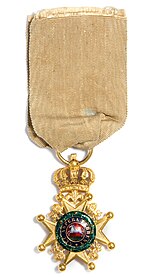Royal Guelphic Order
| Royal Guelphic Order | |
|---|---|
 Grand cross and sash of the Royal Guelphic Order | |
| Awarded by Kingdom of Hanover | |
| Type | House Order |
| Motto | Nec Aspera Terrent (Not afraid of difficulties) |
| Grand Master | Ernst August |
| Grades | After 1841 Grand Cross Commander 1st Class Commander 2nd Class Knight Cross of Merit |
| Former grades | Original Knight Grand Cross Knight Commander Knight |
| Precedence | |
| Next (higher) | Order of St. George (Hanover) |
| Next (lower) | Order of Ernst August |
Ribbon of the order | |



The Royal Guelphic Order (Template:Lang-de), sometimes also referred to as the Hanoverian Guelphic Order, is a Hanoverian order of chivalry instituted on 28 April 1815 by the Prince Regent (later King George IV).[1] It takes its name from the House of Guelph, of whom of the Hanoverians were a branch.
After the defeat and forced dissolution of the Kingdom of Hanover by the Kingdom of Prussia, the order continued as a house order to be awarded by the Royal House of Hanover. Today, its current chancellor is the Hanoverian head of the house, Ernst August, Prince of Hanover. The honour is named after the House of Guelph to which the Hanoverian kings belonged, and its insignia were based on the white horse of that kingdom's arms.
In the United Kingdom it has always been regarded as a foreign order, and even before 1837 members of the order were not entitled to style themselves as "Sir" unless they were also created Knights Bachelor, as many were.
Classes
The Order includes two Divisions, Civil and Military. It originally had three classes, but with several reorganizations since 1841, as house order today it has four classes and an additional Cross of Merit. In descending order of seniority, are:
1815–1841
- Knight Grand Cross (GCH)
- Knight Commander (KCH)
- Knight (KH)
Holders of the respective degrees of the order in Britain were entitled to be post-nominally addressed with the initials, which stand for Knight Grand Cross of Hanover, Knight Commander of Hanover and Knight of Hanover. The initial GCG was also used, and held to be more correct.[2]
After 1841
- Grand Cross
- Commander 1st Class
- Commander 2nd Class
- Knight
- Cross of Merit
The Order
Officers
The Order has six officers: the Chancellor, the Vice-Chancellor, the Register, the King of Arms, the Genealogist, and the Secretary.
Officers until 1837
The first six officers were:
- Chancellor: Count Ernst Friedrich Herbert von Münster
- Vice-Chancellor: Georg Nieper
- Secretary: Ludwig Moeller
- King of Arms: Sir George Nayler
- Genealogist: August Neubourg
- Registrar: Sir William Woods
Officers since 1987
- Chancellor: Ernst August, Prince of Hanover
Notable members
- Field Marshal Arthur Wellesley, 1st Duke of Wellington KG, GCB, GCH, PC, FRS.
- William Herschel
- Sir Augustus d'Este
- Sir John Franklin
- Sir Edward Cromwell Disbrowe
- Sir Benjamin Stephenson
- Walthère Frère-Orban
- Joseph-Pringle Taylor
- Sir Frederick Smith
- Sir William Jackson Hooker
- Sir Charles Webb Dance
- Captain Sir Thomas Lavie R.N., K.H. (1765-1822)
- Sir Thomas Hawker
See also
- British honours system
- List of Knights Grand Cross of the Royal Guelphic Order
- List of Knights Commander of the Royal Guelphic Order
References
- ^ Robertson, Megan C. (2 April 2007). "United Kingdom: The Royal Guelphic Order". Medals of the World.
- ^ Disbrowe, Charlotte Anne Albinia (1903). Old Days in Diplomacy : Recollections of a Closed Century, by the Eldest Daughter of the late Sir Edward Cromwell Disbrowe, G.C.G. London.
{{cite book}}: CS1 maint: location missing publisher (link)
External links
 Media related to Royal Guelphic Order at Wikimedia Commons
Media related to Royal Guelphic Order at Wikimedia Commons

